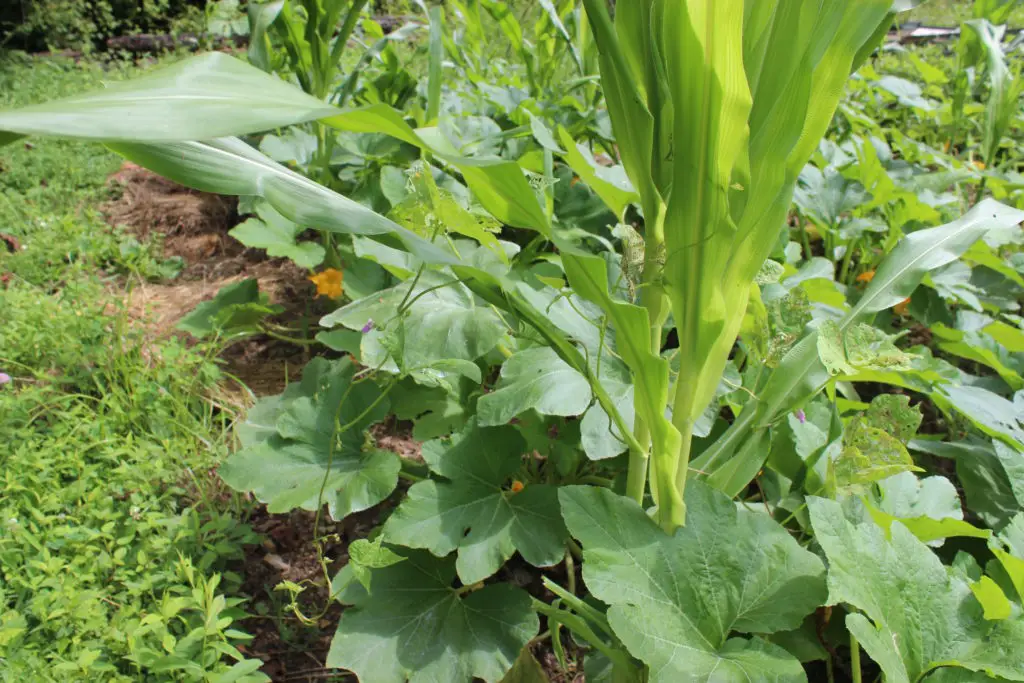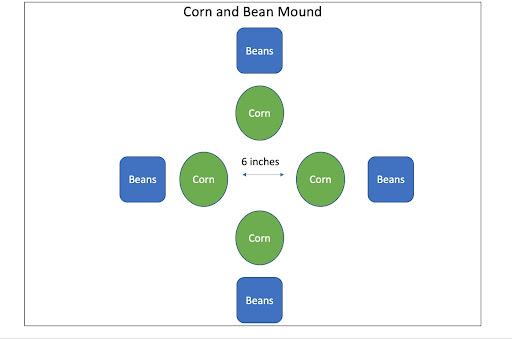The Three Sisters method is a unique form of companion planting with plenty of benefits. It was taught to the early colonial settlers by Native Americans, who used the technique for centuries. Like three human sisters, the Native Americans used this trio of plants because they flourished together. However, rather than planting in neat, even rows, this wild-looking garden offered a more natural means of planting edible plants and helped to provide a well-balanced diet for both the Native Americans and the settlers.
In this article, we’ll take a look at how to plant and grow corn, beans, and squash together to make a three-sisters garden. We’ll talk about how to grow these plants separately, as well. Then, we’ll look at the pros and cons of the three sisters method, and we’ll talk about the fourth sister, too. But first, let’s describe what the three sisters method really is.
What is the Three Sisters Method?
The three sisters method is a form of companion planting of three species of plant together, namely corn, beans, and squash. The vicinity of the other two plants enhances the growth of each plant by enriching the soil and discouraging weeds and pests. The method yields a more abundant crop.
Why the Three Sisters Method Is Beneficial
- Biodiversity attracts pollinators and confuses pests. For example, when you plant rows and rows of the same plant, pests will go from plant to plant, eating the leaves. However, when you use biodiversity in your planting, it confuses the pests and is less likely to destroy your crops.
- The corn acts as a trellis for the beans to grow on, so you don’t need to build trellises or poles.
- The bean vines add stability to the corn so it won’t fall or blow over in the wind- this ensures a healthier, stronger crop of corn with less loss due to storms and bad weather.
- Beans are nitrogen fixers that improve the soil. As a result, the soil is better able to feed the plants as the beans replace the nitrogen used by the corn.
- Squash plants have large leaves that prevent weeds and shade the soil to keep it cool and moist. As a result, you won’t have to weed and water as often with this method.
- The three plants create a balanced diet of carbohydrates, protein, and vitamins, so you have better nutrition.
- The three sisters method saves the work of building trellises, weeding, and watering.
- The three sisters method of gardening saves space since you can plant more vegetables closer together.

How to Grow and Care for Corn
Corn should be planted in the spring after all danger of frost has passed. It needs rich, fertile soil, so mix in plenty of aged compost.
Learn how to raise your own quail and have an unlimited supply of eggs and meat.
Corn is also wind-pollinated, so it needs to be planted in blocks rather than in long skinny rows. Place your rows three feet apart and plant your corn about 3 to 4 inches apart in each row. Plant your corn seeds about an inch deep. You may need to thin the corn plants to about a foot apart once they are established.
Water thoroughly. If you don’t receive at least an inch of rain each week, you’ll need to water your corn to make sure it matures properly. The ears will not be able to develop if the corn does not receive adequate water.
Corn also needs full sun and rich, fertile soil. You can side dress your corn with well-aged compost when it is about two feet tall or give it commercial fertilizer.

You may want to stagger your corn planting every two weeks to have a steady harvest of corn throughout the summer. Your corn should be ripe about three weeks after the tassels emerge from the tops of the corn. You’ll know your corn is ready to harvest if you puncture a kernel of corn and the liquid inside looks milky. If the fluid is clear, the corn isn’t ready to harvest. If the kernel is dry, you’ve waited too long to harvest your corn.
Corn is best when cooked fresh. However, you can store it in your refrigerator for up to a week.
How to Grow and Care for Pole Beans
Pole beans need to be supported by a trellis, wire, or netting because the vines will grow five to ten feet long. Plant your pole beans in full sun, in well-draining, fertile soil. You can add lots of compost to your soil to add nutrients if needed.
You can plant your pole beans in rows that are 2 to 3 feet apart. Plant seeds directly in the soil 4 to 8 inches apart, roughly an inch deep.
Keep them well-watered but not soggy. You should see germination in about eight to ten days.
You’ll know the beans are ready to be harvested when the pods look swollen and full. Don’t wait too long to harvest them, or they will get bitter and tough. You should pick beans every 3 to 5 days to encourage more flowering and vining.
If you aren’t going to use them quickly, blanche and freeze your beans for future use.
Each plant can provide several pounds of beans in a single season. If you want to save beans for the next season, you can allow them to dry on the vine until the beans make a rattling sound inside the pod.
How to Grow and Care for Squash
Squash plants are varied and come in a wide range of colors, shapes, and sizes, such as zucchini, yellow squash, acorn squash, butternut squash, and even pumpkins. Wait until all danger of frost has passed and direct sow your squash into the soil. They don’t like to have their roots disturbed, so direct sowing is better than transplanting whenever possible.
Pick an area that has full sun and rich fertile soil. Add plenty of compost to your soil, too. Check your specific varieties for directions, but typically you’ll want to plant vining squash 3 to 6 feet apart, so it has plenty of room to spread out
Squash needs lots of water. However, try to avoid getting the leaves wet to prevent powdery mildew and other moisture issues.
Depending on the variety, summer squash can be ready to harvest in as few as 60 to 90 days, while winter squash takes 120 days or more.
When harvesting summer squash, err on the side of harvesting them young. Summer squashes can become tough and bitter when left on the vine too long.
On the other hand, winter squashes can be left on the vine longer since they grow a thick, hard rind.
Although it is easy enough to grow these types of vegetables individually, it’s even better when you consider growing them together in a three-sisters garden. Here’s how.
How to Plant a Three Sisters Garden

Three sisters gardening can save you a lot of work if you do it correctly.
As previously mentioned, you’ll save time weeding and watering, and your plants will be just as healthy as if you had planted them in long, skinny rows. However, you need to remember that you are growing more plants in less space. So it will seem like they need more water and fertilizer, but that’s just because they are so close together.
If you only like nice, neat garden rows, this method may not be for you. The three-sisters method can look a little bit wild! That’s because all of the vegetables are intertwined and growing closely together.
If your plants grow well, harvesting may be tricky since it could be hard to reach all of your plants.
Three Sisters Garden Row Method
- Choose your location. You need an area that gets full sun – a minimum of 6 to 8 hours of direct sun per day.
- Amend your soil. Since these plants are going to be planted close together, you’ll want to mix in plenty of compost to improve moisture retention, increase soil nutrients, and create loamy, well-draining soil for your plants to grow in.
- Do not plant until all danger of frost has passed. Traditionally, you would start your three sisters garden when the dogwood tree leaves are as big as a squirrel’s ear. You can check your last frost dates here to find out when to start planting in your area.
- Create your configuration. You’ll need three rows of 5 mounds. The total width of the rows should be about 12 feet wide.
- Each mound should be about 3 feet wide and about a foot high in the center.
- Once the danger of frost has passed, and the soil is around 60 degrees, you can plant your corn. You probably need to plant your corn by June 1st, at the latest, since corn takes a long time to grow.
- Plant your corn in every other mound in your garden square.
- Plant the corn in the mound in the 3, 6, 9, and 12 o’clock positions, leaving about 6 inches in between. Sow 3 kernels per spot, about an inch deep. Water your corn well.

- Once the corn is 6 to 12 inches high, you can plant your beans and squash. This way, the corn will be big enough to support the beans. Plant beans on the outside of each corn stalk.
- Plant squash on the opposite mounds from the corn and beans.

- Alternatively, you could plant your corn in a small circle on each mound.
Three Sisters Garden Circle Method
The three-sisters garden circle method is an alternative layout for planting the three plants together.
- Plant 6 kernels of corn in a small circle in the middle of your mound.
- Once the corn is about a foot tall, you can plant four bean seeds surrounding each corn stalk.
- One week later, plant six squash seeds around the perimeter of your mound, roughly 18 inches apart. You can plant two seeds in each hole.
- Make sure all the plants are well-watered. You can add side-dressings of compost or fertilizer when the corn is about a foot tall.
The Fourth Sister
Sometimes, you may want to add the fourth sister. The fourth sister is typically sunflowers. Sunflowers will help attract pollinators. You can plant the fourth sister in between the corn hills or even in place of the corn if you prefer.
You can raise the sunflowers for cut flowers, seeds for eating, or for feeding livestock.
Tips for Growing Your Three Sisters Garden
If you want to save your own seed for the following year, you’ll want to use heirloom varieties of corn, beans, and squash to get the most consistent results. Although you can plant the seeds from your hybrid plants, you might not get the same variety the following year. However, many hybrid seeds offer disease protection or produce more fruit, so they are worth considering if you have easy access to seeds.
Don’t worry if your three-sisters garden looks a little bit wild; this is normal for companion planting.
If a plant dies and leaves a gap, you can replant fresh seed in its place, and it might produce before the end of the season.
Harvest summer squashes and beans on the early side before they become tough and bitter. Winter squash can be harvested on the late side.
Final Thoughts on Three Sisters Gardening Method
Nature doesn’t plant in nice even rows; it likes to mix things up! So if you’ve never tried the three-sisters gardening method, it is a great experiment in biodiversity, efficiency, and companion planting. You’ll save time preparing garden beds, planting, weeding, watering, and harvesting.

